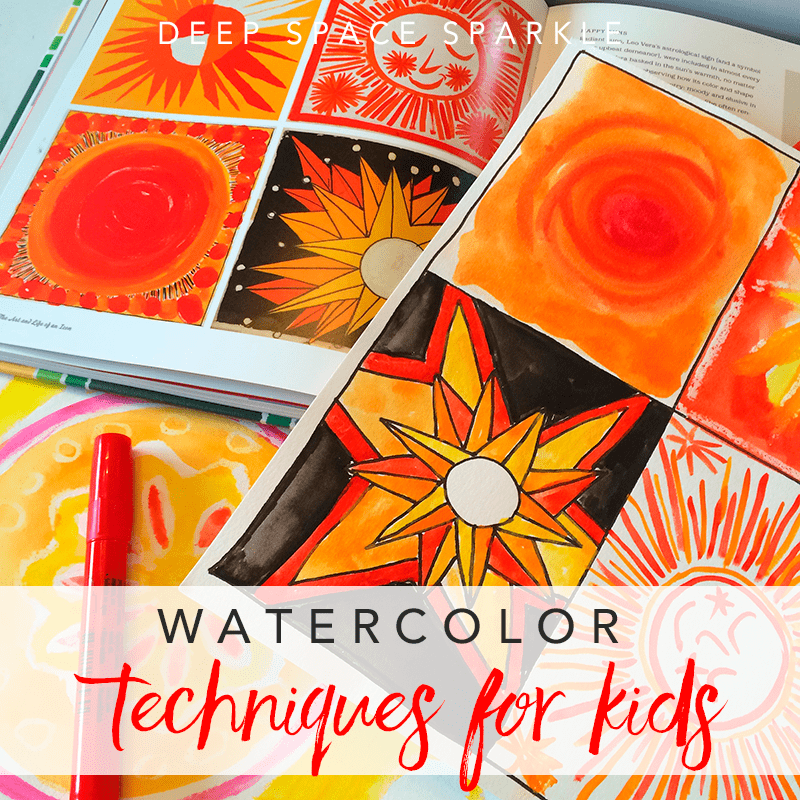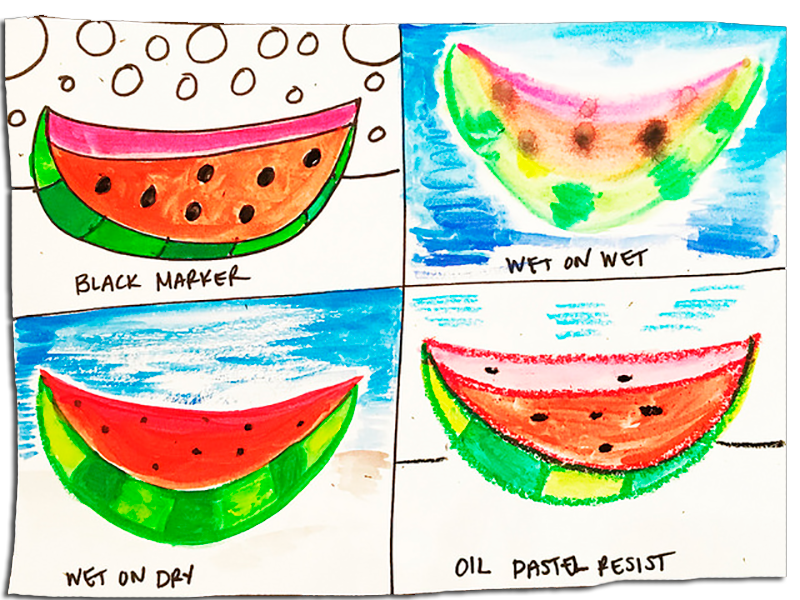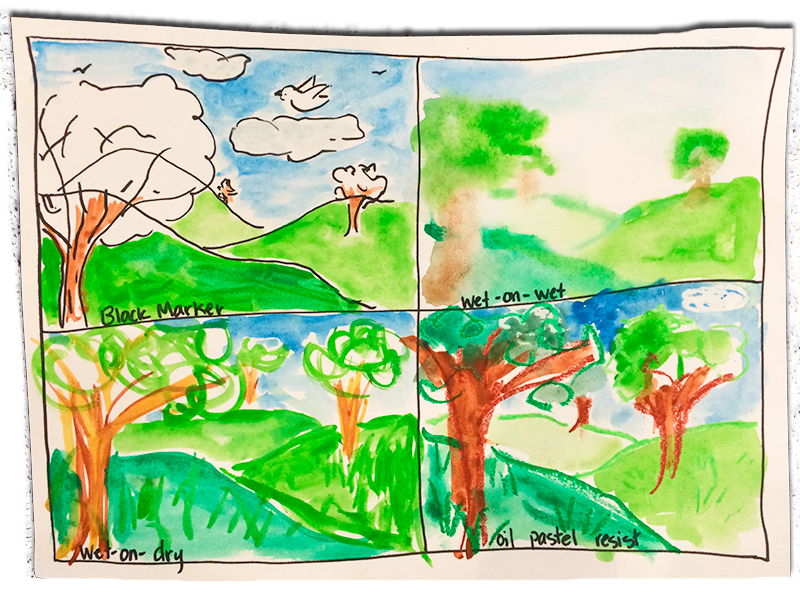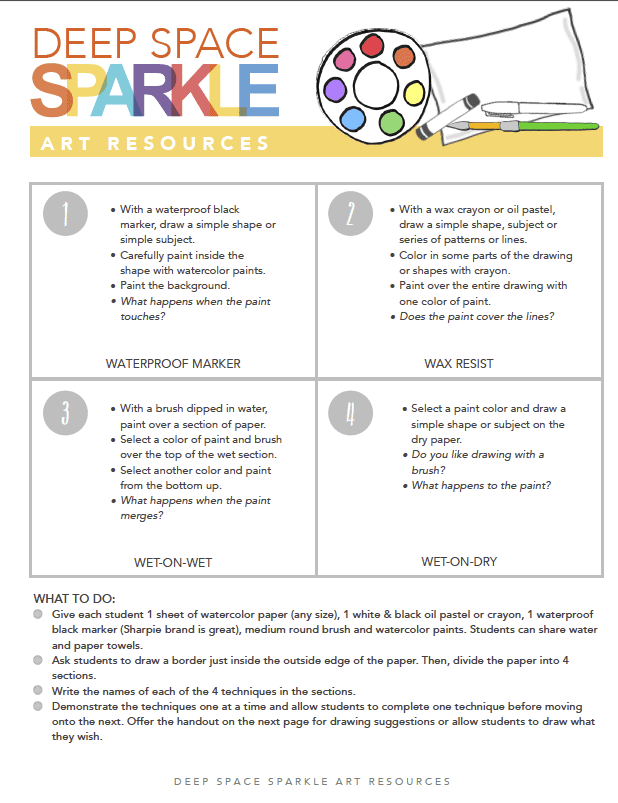
Are you a new art teacher wanting to try a watercolor project with your students? Perhaps you’re an artist who is teaching art to kids for the first time. Determining the best watercolor techniques for young children can be challenging. For children in Kindergarten through fifth grade, I have always found that its best to keep it simple.
Here are my top 4 watercolor techniques that I use with children in grades K-6:
- Wet-on-Wet
- Wet-on-Dry
- Wax Resist
- Black Marker
Last summer, I hosted a workshop for 200 teachers. I demonstrated a simple experiment that is great to try at the beginning of a watercolor unit. You can present it as a practice session before the real project but in fact, the resulting art can be quite beautiful.
I did a version of this experiment with a group of 6th graders (age 11-12) a few years back as a practice for a detailed watercolor project. The experiment helped children identify the properties of watercolor paints and explore all the possibilities of what the medium can do.
You can read all about my 6th grade watercolor experiment here.
WHAT TO DO:
I created a Cheat Sheet for you to download as a guide to help walk you through drawing the grid, the 4 techniques and what to say to the kids. I also included a few simple drawing prompts in case some kids get stuck on what to draw. We don’t want the drawing holding them up as the point of the lesson is to experiment.
The first thing to do is to draw a grid. I demonstrated 4 techniques to my room full of teachers, but you can add or subtract techniques depending on the age of the children or just the complexity of the experiment.
Note: The PDF demonstrates what to do.
Work your way through each of the four techniques. I like to demonstrate ONE technique at a time and allow the children to work for 5-10 minutes on the technique before moving on.


In elementary school, we are always looking for process-based art projects that lead to the development of skills and creativity. Understanding what mediums can do in order to fully express a child’s creativity is a part of this process.
I encourage you to give this experiment a try before embarking on a detailed watercolor project. For little kids, each technique is a project on its own so feel free to experiment with the size of paper and the subject.

DOWNLOAD THE WATERCOLOR TECHNIQUE CHEAT SHEET
Just click on the image below, add your name and email and you will be sent the PDF via your email address (make sure to check you spam/junk mail folder).
Note: You will also be directed to a Thank you page where you can see other freebies that may interest you.













Thanks- I will be using this next week!
Thanks I will going to try this.
Great idea! I ? watercolor.
What is the book used as a visual resource in the first picture?
Vera…life of an artist or something like that. It’s fabulous. About artist Vera Neumann.
I JUST tried this with my 1 – 3 grade class and although the results were not as pretty as your 6 graders I think the kids learned and it was fun. Next time i will dedicate more time to this lesson during my class, this time i did a rather quick instruction before we did our watercolour thank you cards. The cheat sheet is great. Thank you Patty.
Great ideas and would love to try it.
I downloaded the cheat sheet but can’t open it as it was a json file instead of a pdf.
I don’t know what this is & can’t open it.
What program do I use?
Thanks.
I just tested the link and it was working fine. Make sure you have Adobe reader (free) to open the PDF. Your computer might be converting it. I don’t know what a json file is but the handout is a PDF.
Thank you. Love your creative, practical & clever ideas.
Thanks! It’s a great first lesson for watercolor club.
These are so useful to me 🙂 Thanks
I’m a retired art teacher, now working with three home schoolers.
Great ideas and so lovely to have time to work one on one and to be process based. Thankyou for the information and ideas.
Hi, I’m planning on using this next week. Can you do this within a class period (55 min)?
It might take a bit longer to do all the techniques in one sitting especially if you have a large class. I would try reducing the size of the “blocks” so that the area to paint is slightly smaller and perhaps NOT focus o adding too much decorative detail around the edges. Hope that helps…Patty
Awesome! Thanks so much. I just bought a load of watercolours and brushes and wasn’t sure where to start. I will definitely try this next week. Thank you 🙂
It looks great! Yes please!
Thanks for this
I love that you can use these techniques with all grades from K-6th. They turned out great, and was not only fun for the kids, but a great learning experience too.
Thank you.
Great. Thanks
Received a page not found message but the download still worked. Thx
I’m so glad you got this download you were looking for! Enjoy! Thanks so much for bringing this to our attention we will take a look and get this corrected!
cant seem to find this download…it says its missing??
Hi Jill! This is Bethany from Team Sparkle. I just checked all the links and everything is working on our end. If you add your name and email to the box we will send you the PDF directly to your inbox. Enjoy!
Can’t wait to try this.
Thanks.
Could you please mail me the Cheat Sheet as the link isn’t working.
Hi Nikita! This is Bethany from Team Sparkle. Thanks for letting us know about the link. We are working to fix it right away. It should be up and working shortly. Thanks again.
Excellent resource for primary teaching. I’m always looking for ideas that really work. Thank you!
Thank you! I hope to do this project with young kids ages 6-8.